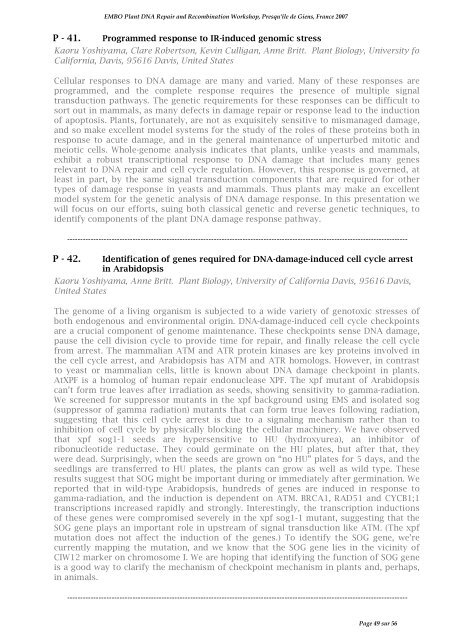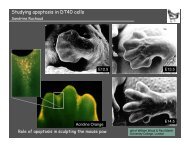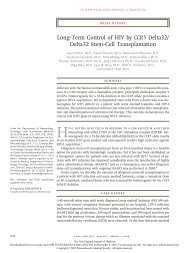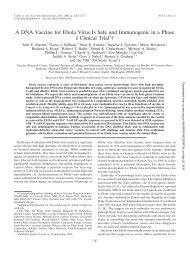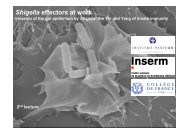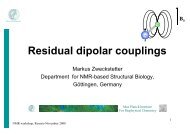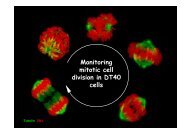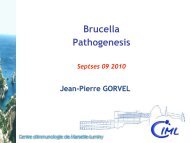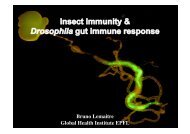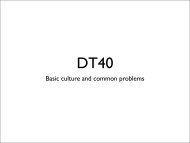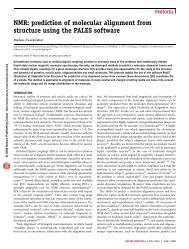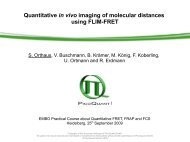pdf file - Events - EMBO
pdf file - Events - EMBO
pdf file - Events - EMBO
You also want an ePaper? Increase the reach of your titles
YUMPU automatically turns print PDFs into web optimized ePapers that Google loves.
<strong>EMBO</strong> Plant DNA Repair and Recombination Workshop, Presqu'île de Giens, France 2007<br />
P - 41. Programmed response to IR-induced genomic stress<br />
Kaoru Yoshiyama, Clare Robertson, Kevin Culligan, Anne Britt. Plant Biology, University fo<br />
California, Davis, 95616 Davis, United States<br />
Cellular responses to DNA damage are many and varied. Many of these responses are<br />
programmed, and the complete response requires the presence of multiple signal<br />
transduction pathways. The genetic requirements for these responses can be difficult to<br />
sort out in mammals, as many defects in damage repair or response lead to the induction<br />
of apoptosis. Plants, fortunately, are not as exquisitely sensitive to mismanaged damage,<br />
and so make excellent model systems for the study of the roles of these proteins both in<br />
response to acute damage, and in the general maintenance of unperturbed mitotic and<br />
meiotic cells. Whole-genome analysis indicates that plants, unlike yeasts and mammals,<br />
exhibit a robust transcriptional response to DNA damage that includes many genes<br />
relevant to DNA repair and cell cycle regulation. However, this response is governed, at<br />
least in part, by the same signal transduction components that are required for other<br />
types of damage response in yeasts and mammals. Thus plants may make an excellent<br />
model system for the genetic analysis of DNA damage response. In this presentation we<br />
will focus on our efforts, suing both classical genetic and reverse genetic techniques, to<br />
identify components of the plant DNA damage response pathway.<br />
----------------------------------------------------------------------------------------------------------------------------------<br />
P - 42. Identification of genes required for DNA-damage-induced cell cycle arrest<br />
in Arabidopsis<br />
Kaoru Yoshiyama, Anne Britt. Plant Biology, University of California Davis, 95616 Davis,<br />
United States<br />
The genome of a living organism is subjected to a wide variety of genotoxic stresses of<br />
both endogenous and environmental origin. DNA-damage-induced cell cycle checkpoints<br />
are a crucial component of genome maintenance. These checkpoints sense DNA damage,<br />
pause the cell division cycle to provide time for repair, and finally release the cell cycle<br />
from arrest. The mammalian ATM and ATR protein kinases are key proteins involved in<br />
the cell cycle arrest, and Arabidopsis has ATM and ATR homologs. However, in contrast<br />
to yeast or mammalian cells, little is known about DNA damage checkpoint in plants.<br />
AtXPF is a homolog of human repair endonuclease XPF. The xpf mutant of Arabidopsis<br />
can’t form true leaves after irradiation as seeds, showing sensitivity to gamma-radiation.<br />
We screened for suppressor mutants in the xpf background using EMS and isolated sog<br />
(suppressor of gamma radiation) mutants that can form true leaves following radiation,<br />
suggesting that this cell cycle arrest is due to a signaling mechanism rather than to<br />
inhibition of cell cycle by physically blocking the cellular machinery. We have observed<br />
that xpf sog1-1 seeds are hypersensitive to HU (hydroxyurea), an inhibitor of<br />
ribonucleotide reductase. They could germinate on the HU plates, but after that, they<br />
were dead. Surprisingly, when the seeds are grown on “no HU” plates for 5 days, and the<br />
seedlings are transferred to HU plates, the plants can grow as well as wild type. These<br />
results suggest that SOG might be important during or immediately after germination. We<br />
reported that in wild-type Arabidopsis, hundreds of genes are induced in response to<br />
gamma-radiation, and the induction is dependent on ATM. BRCA1, RAD51 and CYCB1;1<br />
transcriptions increased rapidly and strongly. Interestingly, the transcription inductions<br />
of these genes were compromised severely in the xpf sog1-1 mutant, suggesting that the<br />
SOG gene plays an important role in upstream of signal transduction like ATM. (The xpf<br />
mutation does not affect the induction of the genes.) To identify the SOG gene, we’re<br />
currently mapping the mutation, and we know that the SOG gene lies in the vicinity of<br />
CIW12 marker on chromosome I. We are hoping that identifying the function of SOG gene<br />
is a good way to clarify the mechanism of checkpoint mechanism in plants and, perhaps,<br />
in animals.<br />
----------------------------------------------------------------------------------------------------------------------------------<br />
Page 49 sur 56


